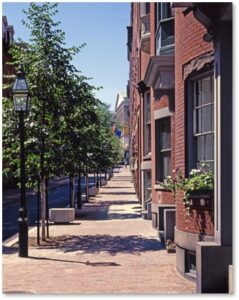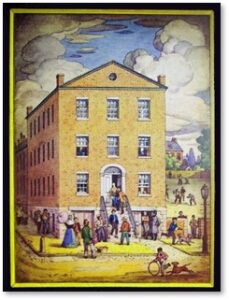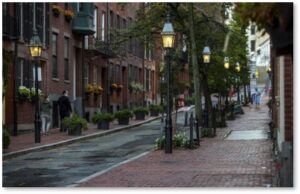The Puritans who founded Boston in 1630 didn’t worship in a temple, or even in a church. In their Protestant theocracy, they marched to the Meeting House, which served dual religious and civil functions.
So why does Boston have a Temple Street?
Like many Boston streets, it was named for a prominent man—or possibly his wife.
Temple Street on Beacon Hill
Temple Street was laid out in 1767 by the heirs of Isaiah Tay along the north slope of Beacon Hill. The partition deeds stated that the Tay heirs had “the privilege of a thirteen-foot way next Beacon Hill, at the foot of the steps on the north side of the hill.” In 1788, this street was called Hill Street and became Derne Street in 1806.
Today, Temple Street runs from Cambridge Street on the north uphill to Derne Street behind the Massachusetts State House. Bowdoin Street parallels it on the east with Ridgeway Street on the west.
Some sources attribute the street’s name to Sir John Temple (1731 -1798), the first British consul-general to the United States and the first British diplomat born in what later became the United States.
Sir John and Lady Temple
A popular man in Boston, Sir John Temple aligned himself politically with the populist faction in Massachusetts politics. He opposed the domination of colonial rule by Thomas Hutchinson and the Oliver family. A man of substance, he would have been worthy of a street named in his honor.
But others say not.
These sources claim that, In an unusual twist on the patriarchy of the times, Temple Street honored his wife, Lady Temple. Before her marriage, Lady Temple was Elizabeth Bowdoin (1750–1809), daughter of James Bowdoin, a patriot and governor of Massachusetts.
Sir John and Lady Temple are, through their daughter Elizabeth Bowdoin Temple Winthrop, ancestors of Presidential candidate, former Secretary of State, and current Presidential Climate Envoy, John Kerry. Mr. Kerry also lives on Beacon Hill.
The Temple family name goes all the way back to Robert de Temple in 1216, which leads me to wonder whether he was connected in some way to the Knights Templar. That order was destroyed in 1312 in France, but the order’s Grand Master might have sent him to England. (There is a rue de Temple in the Marais district of Paris, named for the location of the Paris Temple.) But I digress.
The Temple Street Park
At one time, Boston’s Temple Street held two houses—at #44 and #46—that rivaled wooden buildings on nearby Pinckney Street as the oldest on Beacon Hill. These houses, built in 1787, stood at the rear of the old Bowdoin Street Meeting House and were used by the clergy. The church demolished them in 1952 to put up a parking lot.
Through an agreement with the church, Suffolk Law School, converted the site into a courtyard and pocket park that lay in front of what was then the main entrance to the law school’s addition.
Suffolk University has since left the area to move closer to downtown and the City of Boston now owns the park. The Friends of Temple Street Park help with plantings
The Bowdoin Street Meeting House later became the Church of St. John the Evangelist. Designed by Solomon Willard, this granite structure was built in 1831 by the congregation of the Rev. Lyman Beecher, father of Harriet Beecher Stowe. The congregation of the Bowdoin Street Meeting House disbanded in 1861 and the church then housed other denominations. It is currently empty.
Boston English High School
Boston English High School opened on the corner of Temple Street and Derne Street in 1821 with an enrollment of 101 boys. Its goal was “to educate working-class schoolboys in preparation for business, mechanics, and engineering trades.” The school had a curriculum of courses such as English, surveying, navigation, geography, logic, mathematics, and civics.
“English High” was based on the Royal High School in Edinburgh, Scotland, for students who did not wish to pursue a classical education. Given that a classical education in those days largely consisted of learning, translating and memorizing ancient texts in Greek and Latin, the English High School had a far more practical approach. Today, we might call it Boston’s first STEM secondary school.
Boston English High School remained on Beacon Hill until 1844, when it moved to Bedford Street. In 1881, it shared with Boston Latin School a large new structure on Montgomery Street in the South End that was designed by Boston City Architect George A. Clough. That building was demolished in 1949, when English High moved to Avenue Louis Pasteur to rejoin the Boston Latin School. It was replaced by a parking lot.
Gas Lamps and Toxic Leaks
During updates in the 1960s and ’70s, Boston widened Temple Street’s brick sidewalks, narrowed the road, and banned parking. Temple Street was formally designated a pedestrian street in 1970 by Mayor Kevin White and Governor Michael Dukakis, with an added designation as Temple Walk in 1977. Bostonians don’t give up on their old names easily, however, and Temple Walk has never really caught on.
In 1977, Boston Gas installed 16 quaint gas lamps to make the street look more historic and give a warm glow to the street’s brick homes. Those lamps, proved deadly to the trees planted alongside them, however, due to leaks from the gas pipes,
The Mayor’s office has allocated $400,000 for a pilot project to replace Temple Street’s 16 gas lamps, and also study what it would take to switch all of Boston’s 2,800 gas lamps to LEDs. The LEDs are both cheaper to operate and more environmentally friendly than the cozy and flickering, but uneconomical, gas lamps.
The Archer Residences
 And speaking of uneconomical, Temple Street now houses the Archer Residences, a brand-new ultra-luxury condominium building directly across the street from the pocket park. The condos offer a great location, wonderful amenities, terrific views, and seven-figure price tags. The former Suffolk Law School buildings will also be developed into residential units.
And speaking of uneconomical, Temple Street now houses the Archer Residences, a brand-new ultra-luxury condominium building directly across the street from the pocket park. The condos offer a great location, wonderful amenities, terrific views, and seven-figure price tags. The former Suffolk Law School buildings will also be developed into residential units.
Temple Street is not to be confused with Temple Place, another Boston thoroughfare. That street also holds a lot of history and thus is a subject for separate post.





